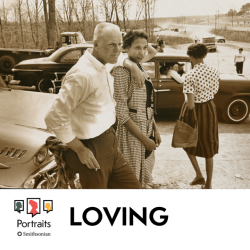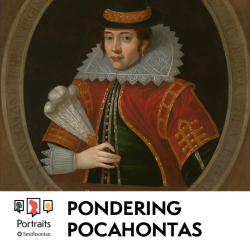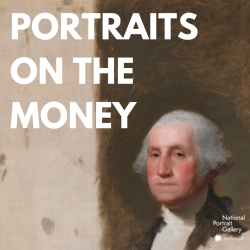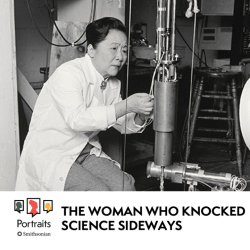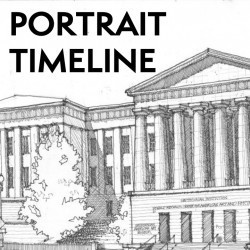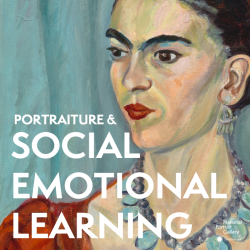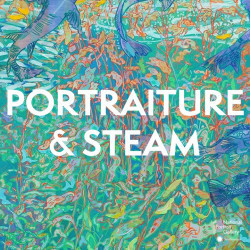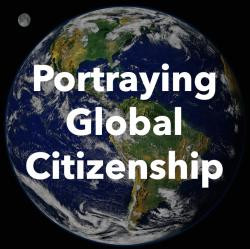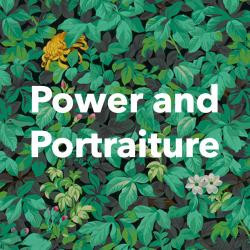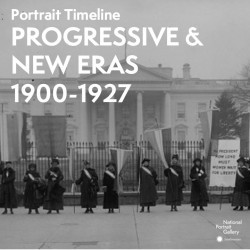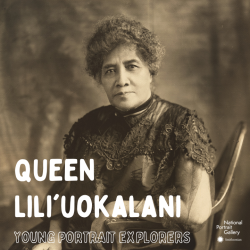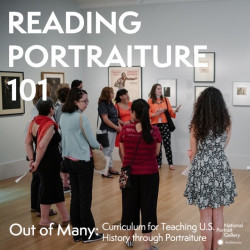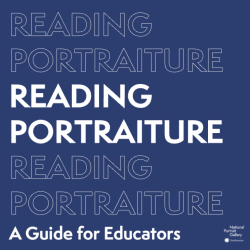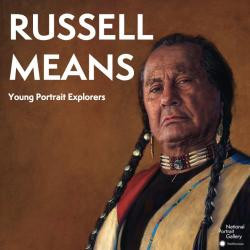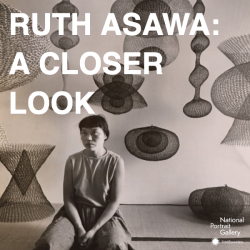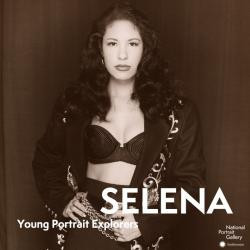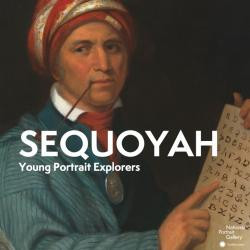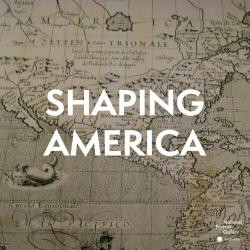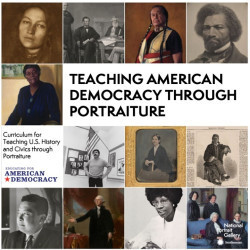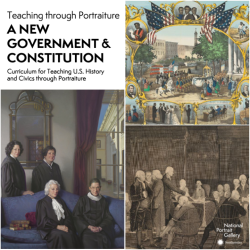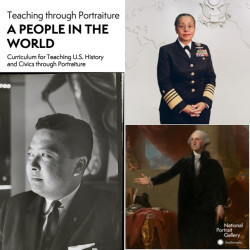Nicole Vance's collections
PORTRAITS Podcast: Loving
<p>In this lesson, students will learn about historical taboos around relationships and race in the United States using a portrait of Richard and Mildred Loving. They will analyze contemporary societal norms around relationship diversity along ethnic, religious, and/or class lines.</p>
<p>This lesson plan was written by NPG Teen Programs Specialist, Sahtiya H. Hammell.</p>
 Nicole Vance
Nicole Vance
19
PORTRAITS Podcast: On the Beat
<p>In this lesson, students will analyze the power of perspective, reflect on "drawn journalism" as portraits, and engage in meaning making around objects in their lives using portraits by artist Wendy McNaughton.<br></p>
<p>This lesson plan was written by NPG Teen Programs Specialist, Sahtiya H. Hammell.</p>
 Nicole Vance
Nicole Vance
24
PORTRAITS Podcast: Pondering Pocahontas
<p>In this collection, students will be better able to identify key elements of a portrait and discuss what we can learn about the sitter through these elements. They will also investigate how these elements may reveal the viewpoints of artist, sitter, and viewer while practicing media literacy skills. </p>
<p>This lesson was written by Erin Koester Tusell, Gallery Educator at the National Portrait Gallery.</p>
 Nicole Vance
Nicole Vance
27
Portraiture and Social Emotional Learning (SEL) with the National Portrait Gallery
<p>This Learning Lab collection complements the National Portrait Gallery's student program, <em>Portraiture and Social Emotional Learning (SEL).</em></p>
<p>The <em>Portraiture and Social Emotional Learning (SEL)</em> student program approaches portraiture with a social-emotional lens. Students will consider how reading portraiture can lend itself to exploring social-emotional qualities such as self-awareness, self-management, social awareness, relationship skills, and responsible decision-making. This collection strives to provide opportunities to explore emotions and values in the context of portraiture.<br></p>
<p><strong>Curriculum Connections: </strong>This lesson plan is suitable for students in grades 4-12 in multidisciplinary classes.<br></p>
<p><strong>Objectives:</strong> After completing this lesson, students will be better able to: </p>
<ul><li dir="ltr"><p dir="ltr">Identify key components of a portrait and discuss what we can learn about the sitter through these components.</p></li><li dir="ltr"><p dir="ltr">Investigate how these components reveal the viewpoints (of artist, sitter, and viewer) represented through the depiction of the sitters.</p></li><li dir="ltr"><p dir="ltr">Identify social emotional qualities and analyze the connections that can be made to portraiture.</p></li><li dir="ltr"><p dir="ltr">Utilize the museum’s collection and portraiture as a springboard to explore the range of social emotional qualities that include self-awareness, self- management, social awareness, relationship skills, and responsible decision-making.</p></li></ul>
<p></p>
<p>#NPGteach<br></p>
<p></p>
 Nicole Vance
Nicole Vance
59
Portraiture and STEAM (Science, Technology, Engineering, Art, and Math)
<p>This Learning Lab Collection complements the National Portrait Gallery student program, Portraiture and STEAM.</p>
<p></p>
<p>Students will explore the ways portraiture can be a springboard to discuss STEAM concepts (Science, Technology, Engineering, Art, and Math). By analyzing portraits, students will consider the sitters’ stories and recognize their contributions to the various STEAM fields. During the program, there will be opportunities to examine a broad range of STEAM topics to allow for classroom connections and emphasis on relevance. </p>
<p></p>
<p>After completing the program, students will be better able to:</p>
<ul><li>Identify key components of a portrait and discuss what one can learn about the sitter through these components.</li><li>Identify and analyze the contributions that sitters made in their STEAM fields of expertise.</li><li>Use the museum’s collection and portraiture as a springboard to exploring a variety of STEAM concepts.</li></ul>
<p>#NPGteach</p>
 Nicole Vance
Nicole Vance
75
Portraying Global Citizenship
<p>Students will analyze portraiture as it relates to global citizenship. Students will identify specific situations where human or cultural factors are involved in global conflict and identify different viewpoints in the struggle and will recognize the cultural contributions of various ethnic groups in the United States to the world.</p>
<p>This learning lab module addresses the following questions through portrait conversations:</p>
<ul><li>What is the role of the US in the world?</li><li>What does it mean to be a global citizen?</li><li>What are some ways that historical figures participated as an active member of the global community?</li><li>What choices did historical figures make that positively impacted you, others, or the environment?</li><li>What choices did historical figures make that negatively impacted you, others, or the environment? </li><li>Is the United States a melting pot or a salad bowl?</li></ul><p>#NPGteach</p>
<p><br /></p>
 Nicole Vance
Nicole Vance
74
Reading Portraiture 101
<p>A portrait is a type of artwork created by artists that illustrate the likeness or image of a person or persons. They can lend insights into history and biography. Portraits can also prompt writing in the classroom, inspire students to create self-portraits, and even offer fruitful ties to multiple disciplines, such as science and mathematics.</p>
<p>In this Learning Lab Collection, educators will learn how to teach students to spot visual clues in portraits and respond to them. In order for students to do so, they need a set of tools to guide them. In this section, educators will find the following tools:<br></p>
<ul><li><em>Defining Portraiture</em> provides educators with a basic lexicon on portraiture.</li></ul>
<ul><li><em>Elements of Portrayal</em> are a series of visual clues that can help students observe and analyze portraiture. Moreover, these different elements relay not only the story of a portrait’s sitter but also the historical and social context in which the portrait was created.</li></ul>
<ul><li><em>Teaching Strategies</em> are a series of protocols that educators can use alongside portraits to bolster learners’ engagement and study. Some of these will be used in some of the lessons throughout the Out of Many curriculum guide.</li></ul>
<ul><li><em>Introducing Portraiture to Students</em> describes an activity that educators can use to begin working with portraits. Students may also fill out the <em>Reading Portraiture</em>
graphic organizer as they investigate each portrait.</li></ul>
<p>Reading Portraiture 101 is associated with the Out of Many Curriculum Guide Series, of which <a href="https://learninglab.si.edu/q/ll-c/pPEjlxzvSDYKI29e">Expanding Roles of Women</a> is the first.</p>
<p>#NPGteach</p>
 Nicole Vance
Nicole Vance
53
Reading Portraiture: A Guide for Educators
<p>The National Portrait Gallery tells the story of the United States by portraying the people who shape the nation’s history, development, and culture. These individuals understand who we are and remind us of what we can aspire to be.</p>
<p>In this guide, you will discover how to teach students to spot visual clues in portraits and then analyze them, similar to dissecting a historical document. Teaching students to use close reading skills with portraiture will produce a rich and memorable investigation of both the sitter and the artist. Use the close looking strategies in this collection as a springboard for classroom conversations. Portraits present insights into history and biography, prompt writing in the classroom, inspire students to create self-portraits, and even offer great ties to science and mathematics.<br></p>
<p>The Learning to Look strategies in this guide offer unique ways to engage in close looking and portraiture with your students. The Elements of Portrayal provide more guiding questions to help you and your students learn how to read portraiture.</p>
<p>#NPGteach</p>
<p>#SummerSessions<br></p>
 Nicole Vance
Nicole Vance
85
Revolution and New Nation (1763-1815) with the National Portrait Gallery
<p>This portrait timeline spotlights portraits of individuals who shaped the history, development, and culture of what is now the United States of America between the years 1763 and 1815.</p>
<p>#NPGteach</p>
<p>Keywords: Revolution, Revolutionary War, Continental Congress, Democracy, Patriot, Declaration of Independence, Constitution</p>
 Nicole Vance
Nicole Vance
72
Selena: Young Portrait Explorers
<p>Learn about award-winning musician and “Queen of Tejano,” Selena.</p>
<p>#NPGteach </p><p>Keywords: Selena, Tejano Music, Singer, Photography, Portraiture. Latinx Musicians, Hispanic Heritage Month</p>
 Nicole Vance
Nicole Vance
31
Sequoyah: Young Portrait Explorers
<p>Learn about Sequoyah (c. 1770 – 1843), creator of the Cherokee syllabary (symbols used like an alphabet), and practice writing skills.</p>
<p></p>
<p>#NPGteach</p>
<p></p>
<p>Keywords: Sequoyah, Cherokee, Writing, Syllable</p>
 Nicole Vance
Nicole Vance
32
Shaping America: Exploring Portraiture from the Colonial Era to the Civil War
<p>This Learning Lab complements the National Portrait Gallery's student program, Shaping America.</p>
<p>Meet the politicians, reformers, inventors, authors, soldiers, and others who shaped the course of American history from the Colonial Era through the Civil War. Students will analyze portraits to learn about the diverse and significant contributions to American society made by individuals in the National Portrait Gallery’s collection.</p>
<p>#NPGteach<br></p>
<p><strong>Objectives:</strong> After completing this lesson, students will be better able to:</p>
<ul><li> Identify important Americans and analyze their contributions to U.S. History</li><li>Identify key components of a portrait and discuss what we can learn about the sitter through these components</li></ul>
<p><strong>Keywords: </strong>Colonies, Revolutionary War, Westward Expansion, Civil War, Abolition, Suffrage</p>
 Nicole Vance
Nicole Vance
72

